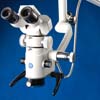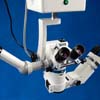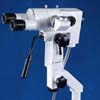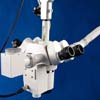Operations
Operations.1. PREPARATION OF THE REGION OF OPERATION, THE INSTRUMENTS, AND THE DRESSINGS; ANESTHESIA.
By G. E. DE SCHWEINITZ, A. M., M. D.,
OF PHILADELPHIA.
ALL the principles of clean surgery and the main practices of aseptic surgery are necessary in all ophthalmic operations.
1. Preparation of the Hands of the Operator. Scrub the hands thoroughly with soap and warm water; then clean the spaces beneath and around the nails; soak the hands in 95 per cent. alcohol for not less than one minute; on removing them place them without drying in a solution of 1 : 1000 corrosive sublimate, and allow them to remain there for at least one minute.
2. General Preparation of the Patient. Necessarily, each patient preceding an operation should be placed in the best possible physical and mental condition. Usually a laxative is advisable. The author is accustomed to give calomel on the night preceding the operation and a saline in the morning.
The nares of patients requiring corneal section should be sprayed either with a mixture of listerin and Dobell's solution or with equal parts of water and the peroxid of hydrogen, which flushes out the passages and probably, largely by mechanical effect, gets rid of infectious material. independently of the fact that chronic bronchitis by virtue of the cough which it produces is a complicating circumstance, it is perfectly possible that pathogenic germs may migrate from the lower respiratory tract and destroy the effects of an operation. Under these circumstances it has been advised to administer capsules of oil of eucalyptus, which is a good stimulating expectorant and plays the part of a mild antiseptic. It is almost needless to point out the necessity of ridding the patient of any inflammation of the conjunctiva, margins of the lids, or lachrymal passages preceding operative interference on the ocular tissues. If there is dacryocystitis, the usual treatment of this affection is indicated (page 268). Haab has recommended sealing the lachrymal puncta with a galvano cautery needle. The inner corner of the eye may be covered with sterile iodoform powder to prevent access of infected fluid from the lachrymal passages to a corneal incision.
3. Preparation of the Skin of the Region of Operation. The skin should be treated first with soap and water, then with alcohol, and finally with corrosive sublimate, 1: 2000. These irritating substances must not enter the conjunctival sac, but the face, surface of the closed lids, eyebrows, brow, and scalp should be thus prepared. The ciliary margins should be cleansed with soap and water followed by bichlorid of mercury, 1:5000. The parts should be kept covered with a compress of lint soaked in a bichlorid solution, I: 5000, which should remain in place for at least one hour before the operation begins.'
4. Preparation of the Conjunctival Cul de sac and the Ciliary Margin. The method to be employed depends upon the nature of the operation. In enucleation, for example, the ordinary rules of antiseptic surgery are applicable, and the same is true, for instance, in an advancement, save only that the strength of the bichlorid solution commonly employed by general surgeons must be decreased. A solution of a grain to the pint is quite sufficient. Numerous investigations have demonstrated that it is impossible to sterilize the conjunctival sac. Therefore the object is to reduce tile vitality of the microbes that cannot be washed away, and the mechanical effect of the fluid used is quite as potent as any germicidal value which it may exercise. Strong germicidal solutions are likely to be deleterious to the delicate epithelium of the corneal tissue. For irrigating purposes the surgeon may employ, provided the fluid reaches all portions of the conjunctival cul de sac and thoroughly scours out the folds of the conjunctiva, boric acid, 4 per cent., or physiological salt solution, which may be prepared by adding a heaping teaspoonful of salt to a pint of sterilized water, bichlorid of mercury, 1: 10,000, or any of the other antiseptics mentioned in the footnote. The. author prefers either the physiological salt solution or the solution of boric acid. As a final precaution the lids should be turned and gently mopped with a pledget of cotton soaked in the antiseptic solution, especial care being particularly taken to cleanse the region of the inner canthus.
The experiments of Bernheim, Stroschein, and many others have demonstrated the impossibility of completely sterilizing the ciliary margin ; hence careful cleansing with soap and water, followed by the salt solution or one of the antiseptics mentioned, accomplishes the only practical result namely, diminution of the vitality and number of the cocei. All of these preparations should be made immediately preceding the operation (see also page 575).
5. Preparation of the Instruments. All coarse 'instruments, such as hooks, scissors, etc., should be cleansed first with soap and water, then boiled, and finally placed in an antiseptic bath, where they remain until required, and they should be covered with this fluid for not less than twentv minutes before the operation. The antiseptic bath may be carboric acid, I : 20, or absolute alcohol, preferably the latter. Immediately preceding the operation the instruments may be removed from the antiseptic bath and placed in a dish of sterile water. Sharp instruments cataract knives, keratomes, cystotomes, etc. must be cleansed with great caution, lest damage be done to their edges. First, the edge of the instrument is inspected with a magnifying glass; then the instrument, wrapped in cotton, is put in the boiling water, and from this transferred to a dish containing absolute alcohol. When the operator is ready the knife is removed from this fluid and the blade freed from alcohol by dipping it momentarily in a vessel containing boiling water. Stroschein and others believe that antisepsis is secured if the blade is rubbed with cotton wool soaked in a mixture of equal parts of absolute alcohol and ether, to which a few drops of ammoniac have been added. Subsequently the knife may be washed in a 5 per cent., solution of carbolic acid. Instead of placing the instruments in absolute alcohol or carbolic acid, it is the practice of sonic surgeons to put them in a physiological salt solution or in sterile water;' or they may be used directly after removal from the boiling water. Perfect sterilization of non cutting instruments made of platinum may be secured by bringing them to a white beat in the flame of a lamp just before the operation (Gruening).
Dr. E. A. de Schweinitz recommends sterilization of instruments with the vapor of formaldebyd. The practical value of formaldehyd in the disinfection of small instruments has also been demonstrated by H. 0. Reik and W. J. Watson,' who have designed a special sterilizing apparatus.
6. Dressings. These must be modified according to circumstances. In plastic operations about the lids the ordinary antiseptic dressing is usually applied protective and antiseptic gauze covered by a wet or dry bichlorid roller. Iodoform is also used under these circumstances, although sonic surgeons for example, Noyes do not consider it an advantage. Dressings impregnated with antiseptic substances bought ready made from the various shops are not satisfactory. Sterilization with steam is the proper method. If a wet dressing is desired, the fabric may be soaked in one of the antiseptic fluids, usually bichlorid, I : 0 000, or in a physiological salt solution which has been sterilized by boiling. Bits of gauze prepared by sterilization with steam are much more desirable than cotton for removing blood, etc. from the area of operation. If the lighter forms of cataract dressing are employed, such as isinglass plaster or small wads of cotton held in place by strips of surgeon's isinglass plaster, these should be properly disinfected before application.
When the eye is bandaged, either the single (Fig. 333) or the double bandage (Fig. 334) is employed, or a modification of Liebreich's bandage (Fig. 335). In most cases a dry, absorbent material for example, gauze sterilized by heat, is most useful, although there is no objection to a flannel roller, if it is desired, when this is placed over a properly applied antiseptic pad. The dressings applicable to the different operations vary according to the desire of the surgeon. Cataract dressing is described on page 581. In addition to the dressing recommended there, Ring's ocular mask (Fig. 336), which covers the bandage, and which may be understood by a reference to the figure, is of great advantage.
Sutures. These may be of catgut or silk. The latter is usually black, ordinarily known as iron dyed, although for delicate sutures in the conjunctiva the white silk such, for example, as comes in Stevens's tenotomy case is of great advantage. These sutures should be soaked in an antiseptic bath preparatory to their use.
Catgut specially prepared by the instrument maker may be purchased, but it is better for the surgeon to prepare this for himself. The author is accustomed to use a delicate sulpho chromic surgical gut, which is kept in a solution of bichlorid of mercury in alcohol, 1: 1000. If sponges are used in plastic operations or in enucleation, they should be properly disinfected by the ordinary processes. Generally, the area of operation may be kept clean by gently touching it with cotton soaked in bichlorid solution, or by gauze which has been sterilized by beat.
General Anesthesia. The indications for general anesthesia in ophthalmic surgery are limited. In children or in very nervous adults, and for enucleations, blepharoplastic operations, occasionally in advancements, and usually in cases of glaucoma, general anesthesia is necessary. The surgeon must decide between ether and chloroform. The author prefers the former, believing it safer than chloroform or the A. C. E. mixture. Bromid of ethyl has been recommended and much employed, but the author has not been favorably impressed with its value.
Local Anesthesia. When local anesthesia is required, usually hydrochlorate of cocain is employed in 2 or 4 per cent. solution (some surgeons use a 10 per cent. solution). Various fungi grow readily in solutions of this alkaloid, and, indeed, in solutions of any of the alkaloids commonly used in ophthalmic practice. A number of methods of sterilization are employednamely, sterilization by beat, by the addition of an antiseptic (I : 5000 solution of bichlorid of mercury, 4 per cent. of boric acid, formaldehyd, as recommended by Valude, or trikresol, 1 : 1000, as recommended by E. A. de Schweinitz of Washington), or by a combination of these two methods. The most satisfactory procedure is to boil the solution. A number of convenient flasks for this purpose are in the market, among the best being those introduced by Stroschein of Wurzburg (Fig. 337), and the one devised by Llewellyn of Philadelphia (Fig. 338). The Stroschein flask may be understood by a reference to the figure. The solution is placed in the Llewellyn flask and boiled. After the liquid is cool and ready for use the warmth of the band causes the fluid to drop from the end of the pipette. If it is desired to preserve the solution after boiling, a portion of one of the antiseptic substances previously mentioned may be added.
In order to avoid the drying and roughening of the corneal epithelium caused by cocain the lids should be kept closed after each instillation. The drug should not be used too freely or it may, according to Mellinger, prevent closure of the corneal wound. Three instillations of a 4 per cent. solution, five minutes apart, are sufficient for a corneal section. Gelatin disks impregnated with cocain, as recommended by some surgeons, have no advantage over the solution, and general anesthesia is preferable to strong solutions of cocain, which have been recommended in the operation of curetting lupus and similar growths.
In addition to cocain, a number of other substances (for example, tropacocain) have from time to time been recommended as local ocular anesthetics, but without establishing claims to special favor. Three may be briefly described:
(1) Hydrochlorate of eucain "A," like cocain, is a local anesthetic, and may be employed in 2 per cent. solution. Its application is followed by very considerable smarting and conjunctival congestion. It has little or no effect upon the pupil, and is said not to cause drying of the corneal epithelium. The anesthesia begins in a few minutes and lasts from ten to fifteen minutes. The author has been unable to see in what way it possesses any advantages over cocain.
(2) Hydrochlorate of eucain ‘’B “is related to eucain "A," and also to cocain and tropacocain. It is not decomposed by boiling, and is less irritating than the older eucain, according to Silex. A 2 per cent., solution causes local anesthesia in from one to three minutes, which lasts about fifteen minutes.
It does not dilate the pupil, apparently does not decrease intra ocular tension nor cause clouding of the corneal epithelium.
Holocain, (p diathoaxythenyl diphenylamidin), introduced into ophthalmic therapeutics b Hirschberg and Gutmann, and originally known as “amidin," is an active local anesthetic closely allied in its general properties to phenacetin. A I per cent., solution causes anesthesia in from fifteen seconds to one minute, which lasts for ten minutes, preceded by a moderate burning sensation. Hasket Derby considers it advantageous because it does not enlarge the pupil, does not affect the accommodation, does not increase intraocular tension, and is itself bactericidal. Holocain is highly recommended by H. V. Wurdemann.
Infiltration anesthesia. In lid operations cocain solution, 2 4 per cent., is sometimes injected beneath the skin, but a more efficacious and safer procedure is the so called infiltration anesthesia introduced by. C. L. Schleich.' This consists of an intracutaneous (not subcutaneous) injection, with a hypodermic syringe or with one specially devised for the purpose, of a 1/5 per cent., solution of sodium chlorid, which is reinforced b the addition of from I/100 to 1/50 per cent., of cocain. The fluid injected produces edema, and the anesthesia is strictly limited to the edematous area.
Eucain has been much employed hypodermically, and also by the infiltration method. The general toxic effects which sometimes follow hypodermics of cocain do not appear with eucain, but sloughing of the tissues has been reported.
Back to Resources
call toll-free:  or email
or email

 or email
or email
Categories
Categories
Dental
Dental Microscopes
Dental Microscopes
Ophthalmic
Ophthalmic Microscopes
Ophthalmic Microscopes
Gynecology
Gynecology Colposcopes
Gynecology Colposcopes




